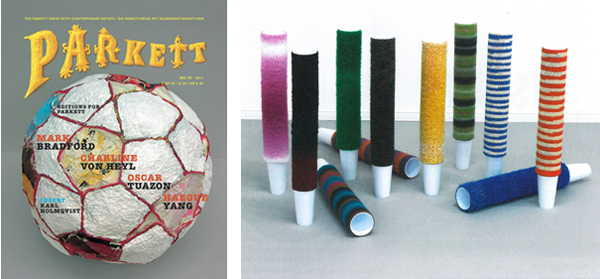News
파켓(Parkett) 매거진 NO.89, 2011: 양혜규 작가 소개

CUP COSIES, 2011, knitting yarn in varying colors and patterns,
each unique, 100 plastic cups, approx. 27’’ high, diameter 4 1/8’’
* 담당자: 전민경(02-3210-9885)
* 파켓 웹사이트: http://www.parkettart.com
2011년 89호 파켓에서는 콜라버레이션 작가들 중 양혜규를 선정하여 이를 심도 있게 다루었다.
또한 선정된 작가들은 파켓을 위한 리미티드 에디션 작품을 제작하여, 전세계 파켓의 쇼룸에 선보이게 된다. 양혜규는 파켓의 에디션 작품인 CUP COSIES 제작을 위해, 작가가 가장 좋아하는 행위인 “실뜨기”에 다시금 매진하여, 하얀 플라스틱 컵을 패턴이 있는 털실 통으로 감싸는 독특한 작품 시리즈를 제작하였다.
국제갤러리 전속작가인 양혜규의 경우, 저술가이자 이론가인 마리나 비슈미트, MoMA 큐레이터 정도련, 그리고 작가 지미 더럼의 소개와 심도깊은 비평을 담은 에세이로 작가의 작품과 작품세계가 소개된다.
특히 마리나 비슈미트는 양혜규 광원 조각에 대해 바퀴 달린 행거에 전구와 전선이 서로 엉키고 뒤섥여 있는 광원조각을 “가정용품의 단조로운 상징성”이라고 표현하였고, 이에 대에 작가는 일상적 오브제들을 비유적으로 해석하는 본인의 태도에 대해 “내가 무엇을 선택하던지, 나는 누군가를 묘사하기 위해 사용한다.”라고 언급했다.
정도련은 양혜규의 작업을 대중적인 재료주의(exoteric materialism)와 소수를 위한 개념주의(esoteric spiritualism)의 지형학을 건너는 차원의 도약의 관점으로 작품을 언급하였다. 이외 지미 더함과 양혜규의 인터뷰에서, 양혜규는 그녀의 직업의식에 대해 논의하는 것을 지양하고 오히려 일반적으로 언급되지 않는 작가태도에 대한 내용을 논의 하였다.
* 파켓(Parkett)
파켓은 현대미술을 전문적으로 다루는 국제적인 미술 잡지로, 1984년 창간 이래 연간 세 차례 영어와 독어로 발간되며 취리히 및 뉴욕에 지사를 두고 있다. 파켓에는 미술계를 주도하는 저술가, 비평가, 큐레이터, 미술 사학자들이 참여하여 세계적인 작가들의 작품을 다룰 뿐 아니라, 매 호 발간 시 주목할 만한 젊은 현대미술 작가를 선정하여 작품 제작을 공동으로 진행하는 시스템을 갖고 있다. 전세계 40개국 출판, 3만 명이 넘는 독자를 보유하고 있는 파켓은 특히 북아메리카의 경우 인구의 삼분의 일 가량이 파켓 구독을 할 정도로 높은 인지도를 자랑한다.
The new Parkett takes its readers up front and close to its collaborating artists Mark Bradford, Oscar Tuazon, Charline von Heyl, and Haegue Yang. Each artist has also made a limited edition especially for Parkett. Additional texts in this Parkett: Daniel Schwartz by William A. Ewing; Mona Hatoum byJacqueline Burckhardt; and a conversation on sound in art between Kabir Carter and Alan Lich.
Christopher Bedford of the Wexner Center explores Mark Bradford's "shimmering grids," that to him evoke the live news footage shot by ominous helicopters hovering over Los Angeles. Tate Modern curator Jessica Morgan elaborates on Bradford's assorted paper trail revealing a frantic ethos of pest control, cheap divorce, prison phone services, money wires and credit lines. Bradford employs his unmistakable technique of collage and de-collage to confront and expose issues of what the art historian Huey Copland calls "the socially dead," and "politically, disenfranchised" but with an inspiring force that makes us stop and take note. In his edition for Parkett, THE ONCE AND FUTURE KING, Bradford retells the ancient legend of King Arthur by submerging a switchblade rather than a sword in a solid rock.
Encountering one of Oscar Tuazon's large concrete pavilions is like coming across a half completed abandoned construction site years after the fact. But this frozen moment is intended to exhibit a realism of failure and obsolescence. Tuazon's ambitious structures never quite arrive at a finished state and never quite state their purpose. To Kunsthalle Bern's director Phillipe Pirotte they evoke a sci-fi dystopia or the doomed efforts of the 1960s. Eileen Myles envisions a sexualized Tuazon "bursting through walls humming a silly song". Commiserating with fellow artist K8 Hardy on survival in the art market, Paris-based Tuazon acknowledges an irony to his reluctant achievements: "the idea was to build a huge concrete structure, lift it up, turn it over, and let it collapse under its own weight. Technically it was a failure. I mean, it didn't collapse." For his edition, ALLOY (FOR STEVE BAER), Tuazon has welded together alloy nuts (think wrench) into a heavy table size geometric form.
After a few days alone in Charline von Heyl's studio, painter Joan Waltemath inhabits not just the paintings but her own fantasy of von Heyl at work: the artist has "let a genie out of a bottle, both to conjure and tame the demons that inhabit an unknown realm." Poet John Yau remarks on von Heyl's inner-rascal, summing up her deliberate stylistic inconsistencies: "instead of making work that is either nostalgic for modernism or satisfied with reiterating painting's death," her tactic is to sabotage painting for the sake of invention. Artist Mary Simpson acknowledges that in our image-saturated culture, it is a radical act to simply stop a viewer in ones tracks. For her edition, LACUNA LOTTO, von Heyl has emerged from the print studio with a series of unique black and white monotypes (with lithograph collage) featuring her elegant tenacity and dramatic sense of line.
Writing on a body of Haegue Yang sculptures, hanging racks on wheels strewn with lights, extension chords, and what writer/theorist Marina Vishmidt calls a "humdrum of household goods," the Korean born artist admits her tendency to interpret objects figuratively, saying: "Whatever I pick up, I use to portray someone." Her well-known venetian blind installations conjure the nocturnal word of the private eye detective. MoMA curator Doryun Chong sees Yang performing dimensional leaps across a topography of "exoteric materialism and esoteric spiritualism." Yang pauses to discuss her work ethic in a conversation with artist Jimmie Durham. For her edition, CUP COSIES, Yang has returned to one of her favorite activities, knitting, producing a unique series with patterns of yarn cylinders wrapped around white plastic cups.
* 영문출처: http://www.e-flux.com/shows/view/10386
01
05


